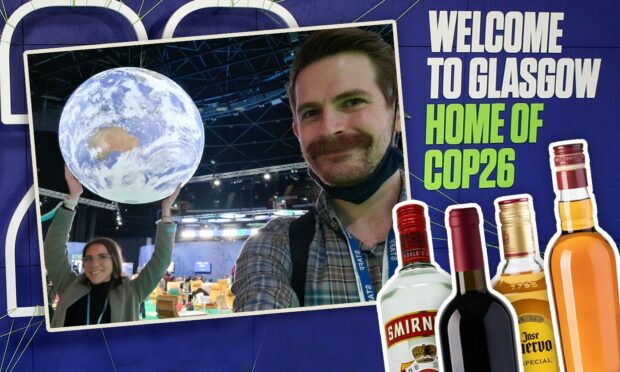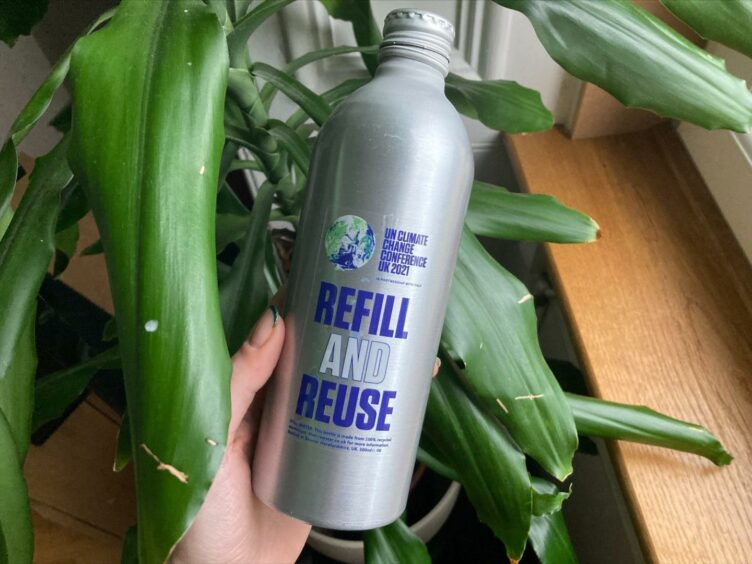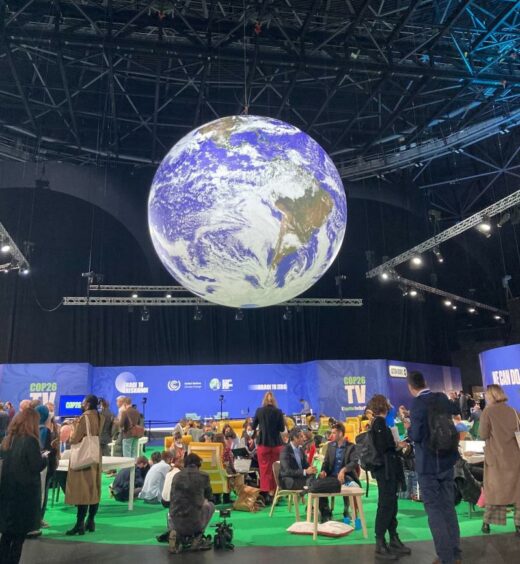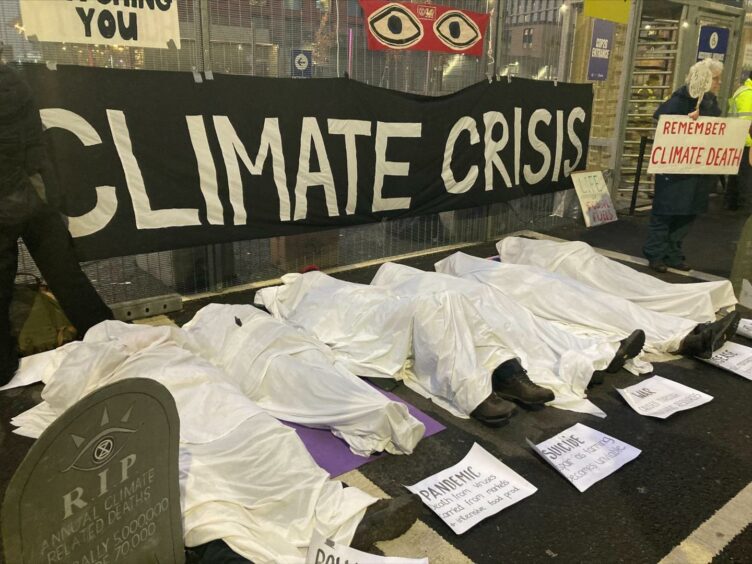COP26 has dominated the news for the last two weeks, and for good reason. We sent reporters Philippa Gerrard and Kieran Beattie to find out what it’s like behind the headlines.
Imagine you’re in an airport, a big one, with thousands of people from all over the world milling around you, each with their own destination in mind.
That’s what COP26 is like.
The P&J environment team (@PhilippaGerrard and yours truly) are on a one-day whirlwind visit to #Cop26! Exciting to be here, and can't wait to meet visitors from across the globe, and from across Scotland! pic.twitter.com/55EcT1sJxe
— Kieran Beattie (@KNBeattie) November 11, 2021
At the extremely vigorous security, my bag set off an alarm on the scanner.
Of all things, it was a padlock which had caught their attention. Floating around in the bottom of my bag and usually used for a gym locker.
A drinks cabinet stuffed with booze seized from visitors
A burly UN security officer dressed in his official blue uniform informed me that padlocks were banned, and handed me a cloakroom ticket to claim it back when I was leaving.
When I did just that several hours later, a different security officer swung open the doors to two large metal cabinets packed to the rafters with booze.
Whisky, vodka, wine, tequila, champagne, the seized drinks selection was about as international as the conference itself.
“Are these all the confiscated items?” asked my colleague Kieran, staring in awe at the vast array of expensive whiskies crammed onto the bottom shelf.
“Do you get to take these home if no one collects them?” he added.
Rooting around on one shelf for my padlock, the security officer confirmed these were indeed all from visitors at the conference, but no, security not get to take them home. If not collected, they had to be poured down the sink.
“Criminal!” said Kieran, and the officer laughed in what we took to be agreement.
We nearly asked to take a picture, but that might have been pushing our luck.
Plus, he was holding a gun.
Forget plastic tat
Being a conference focusing on climate change and sustainability, it was clear that this had been built into the planning of the whole event.
Forget useless plastic keyrings and cheap branded pens being handed out by exhibitors, instead everyone was given a reusable aluminium water bottle.
Order a coffee anywhere in the conference venue and you’d be given it in a reusable plastic cup which was collected, washed and reused.
While we were there, Scottish Greens MSP Lorna Slater revealed that legislation has been laid which will see Scotland ban several environmentally damaging single-use plastic items like coffee stirrers and takeaway boxes.
We spoke with @lornaslater of the @scottishgreens about the plans revealed today for banning many single use plastics in Scotland, like cutlery. We asked about the impact on businesses that use such plastics. Lorna says "Polystyrene is a thing of the past". Watch below 👇 #cop26 pic.twitter.com/3nLxZxnrTZ
— Kieran Beattie (@KNBeattie) November 11, 2021
We got chatting to her and –amongst other more serious questions – asked if she’d ever tried drinking a McDonalds milkshake through a paper straw.
She has not, though does carry a reusable straw and cutlery with her in bag at all times.
Later I wondered if she’d had them seized at the conference entrance as there were an unexpected number of forks and knives in the confiscated items cabinets.
Doing a half marathon at COP26
The conference guest list looked amazing, though sadly big names like former US President Barack Obama and Sir David Attenborough had been and gone by the time we arrived.
Cabinet secretary for net zero, energy and transport Michael Matheson was the most famous person we spotted (at least we think it was him, getting interviewed by a TV crew as we sped past).
But despite the lack of famous faces for us, there was still a genuine buzz about the place.
Snippets of languages from all corners of the world could be heard as delegates paced through the venue.
And we had a bit of FOMO (fear of missing out) as we watched it all happening – the constant rolling screens of meetings and events happening at every minute of the day was overwhelming.
What's it like in the Pavillions area of #cop26 ? pic.twitter.com/hPzuHpHyu1
— Kieran Beattie (@KNBeattie) November 11, 2021
Think back to the airport comparison and the constantly updating departures and arrivals lists and you get the idea.
It felt like an airport in size too.
The Clydeside complex, which includes the distinctively-shaped Armadillo and Hydro concert venues, had been significantly expanded with a series of interlinked temporary buildings on the site.
Over the course of the day there, we walked more than 21 kilometres around Glasgow and the venue (according to my fitness watch).
A disappointing COP26 public offering
I was beginning to get concerned that the glitz and glamour of the whole spectacle – including the giant spinning globe there to focusing people’s minds on the planet everyone is there trying to save – was overshadowing how serious the negotiations needed to be.
At the Panda Hub (the creatively named WWF stand) we asked Lang Banks, director at WWF Scotland, that very question.
He admitted that COP conferences of the past were certainly smaller in size, but said that having civil society groups like businesses and state governments present was increasingly important.
“After all, it’s them who will have to implement whatever is agreed,” he said.
Managed to grab director of WWF Scotland @LangBanks for a wee chat. Asked him if the crisis the climate is facing has gotten a bit lost in all the glitz, glam and sheer size of COP26… #COP26 @pressjournal pic.twitter.com/le4qazVRvM
— Philippa (@PhilippaGerrard) November 11, 2021
After wondering round in circles for a while, we decided to visit the part of the conference accessible to the public.
Touted as a place with “over 100 exhibitors and 200 events”, we were expecting great things.
Instead, we arrived to a large room in the Glasgow Science Centre with fewer than 10 stalls.
It felt rather small and DIY compared to the hundreds of professional pavilions in the main conference centre.
A brief tour of what it's like in the main bits of the publicly accessible Green Zone at #COP26. Quite a difference from what we've seen so far. pic.twitter.com/Z2Xvw2pHUU
— Kieran Beattie (@KNBeattie) November 11, 2021
This was followed by a much larger and more grand room with the sponsor stalls, dominated by the likes of Unilever, Sainsbury’s and Sky.
Although there was a nice atmosphere and the place was busy with visitors, it was a rather disappointing offering to the folk of Glasgow who have had their city commandeered by the conference for the last two weeks.
Going home to climate death
By 6pm things were beginning to slow down a little. Or at least that’s what we told ourselves.
It had been a hectic day and we had a train to catch back up north.
As we exited the complex, we walked past a group of protesters lying in a row under white sheets, only their boots poking out from the end.
Surrounded by cardboard gravestones, they were pretending to have died as a result of the climate crisis.
They had been there when we first arrived several hours previously and I thought they must be incredibly cold and stiff by now.
Kieran meanwhile was more cynical and asked a nearby security guard if there “really were real people under there”.
He said that there were, but just shrugged and laughed when Kieran asked what he thought of them.
And just like that our one day at #cop26 is over and we're away on the next train back to Aberdeen. Our closing remarks next to a very over-exposed giant spinning 🌎 @PhilippaGerrard pic.twitter.com/uqanSuuEJ9
— Kieran Beattie (@KNBeattie) November 11, 2021
For us, that sort of summed it up.
On the one hand COP26 is a deadly serious climate event, and the consequences of getting negotiations wrong will undoubtedly be catastrophic.
On the other hand, it had been a mixture of outlandish wealth and bizarre demonstrations.
While celebrities and world leaders arrived on private jets with a huge security detail and the streets filled with all kinds of weird and wonderful activists doing anything to grab your attention.
Whether it has all been enough to save the planet, we must wait to find out.



